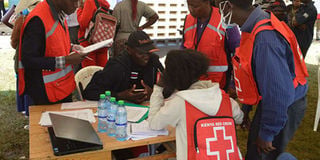Only way to prevent disasters is anticipate and plan carefully

Kenya Red Cross staff set up an information desk at Kericho County Referral Hospital mortuary on October 11, 2018, where relatives of the passengers who died in a road crash can get updates. PHOTO | ONDARI OGEGA | NATION MEDIA GROUP
What you need to know:
- Disaster management can no longer be in the aftermath when we can be deliberate and proactive to save lives, property and livelihoods that our economy depends on.
- Stakeholders in disaster management must now seek to proactively inform people of the disaster hazards, risks, and involve them in disaster reduction.
A word commonly misused with little regard for its meaning and effect is “Disaster”.
“The meeting was a disaster.” “The whole process is a disaster” et al. The Oxford Dictionary defines disaster as a sudden accident or a natural catastrophe that causes great damage or loss of life. Perhaps we ought to be more cautious and sensitive in our lexicon.
The real disasters in the true intended meaning are the Solai Dam incident, which qualifies as a sudden accident albeit with reservations on accident and the recent Tsunami in Indonesia, which is a natural catastrophe.
Between these two catastrophes, which one could have been prevented from occurring or its subsequent damage and loss of life reduced? We were risk averse with Solai Dam?
FRAMEWORK
Today we mark International Day for Disaster Reduction. The objective of this day has always been to promote a global culture of risk awareness and disaster reduction.
How are we as a country reducing our exposure to disasters and raising awareness about the importance of reining in the risks we might face?
The 2018 edition continues as part of the "Sendai Seven" campaign, centred on the seven targets of the Sendai Framework.
The aim of the framework is to achieve substantial reduction of disaster risk and losses in lives, livelihoods, health and in the economic, physical, social, cultural and environmental assets of persons, businesses, communities and countries.
This year we focus on Target C of the Sendai Framework, reducing disaster economic losses in relation to global GDP by 2030.
But what should we be wearier of, disaster risk or disaster loss? Disasters often do not suddenly arise.
PREVENTION
There are usually early warning signs of impending disaster, and the signs are often triggered by the underlying hazard, much like a common trip hazard.
If the hazard is not removed or addressed, then there is a higher risk of the disaster occurring and the consequential loss could be far disproportionate to the loss that would have occurred had the signs been addressed.
Crucially, disaster loss is not always felt within the immediate area where the disaster occurs. It could spill over to other areas causing greater damage and loss of lives.
The effects of the widened scope of the disaster then have more far-reaching negative consequences to the economy.
With the increased and further extensive damage, the sustainable capabilities of the affected county(s) are more compromised and subsequently the country as it grapples with the disaster.
MANAGEMENT
How then can we have effective disaster management that goes beyond the risk to the hazard?
As highlighted in the Hyogo Framework for Action 2005-2015, we need to promote a culture of disaster prevention.
Where areas are known to be prone to disasters such as flooding and drought, we should by now have a protocol to carry out early risk assessments and mobilise adequate resources early enough to start addressing the oncoming disaster.
Disaster management can no longer be in the aftermath when we can be deliberate and proactive to save lives, property and livelihoods that our economy depends on.
Even more crucial, our early warning systems must be people centred. Which demographic would be most affected by the disaster?
Children and the elderly tend to be remembered in hindsight when the call to action for disaster resolutions are being sought.
VULNERABLE
More laterally, which gender, culture and livelihood are at a higher risk? We have time and time again witnessed the dire effects of drought on the livelihoods of our pastoralist communities.
Is pastoralism in danger of being made redundant with each occurring drought?
Once these early warning signs and effects are identified, the populace at risk is the one which needs immediate and urgent guidance on how to act on those warnings.
It’s all well and good for the Disaster Operation Centre to have this insight, but its futile if the knowledge is not passed on to the likely victims and practical steps are not taken to tackle the disaster.
AWARENESS
Beyond tackling the disaster and mitigating loss, stakeholders in disaster management must now seek to proactively inform people of the disaster hazards, risks, and involve them in disaster reduction.
With devolution, there is now more ease for public participation in disaster management.
If deliberate, every county can build the necessary capacities to manage and reduce disaster risk and loss.
These include scientific and technological infrastructures needed to research, observe, analyse, map and where possible forecast natural and related hazards, vulnerabilities and disaster impact.
There is even more scope to systematically tailor make policies, plans and programmes that cater to each county’s disasters without competing for resources and urgency from other areas. Together, we can all embrace a culture of disaster prevention.
Burini works with international businesses on commercial litigation. gladysburini1@gmail.





